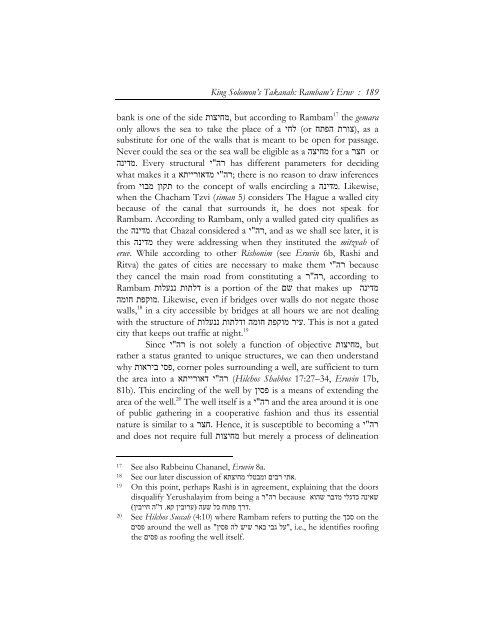King Solomon's Takanah: Rambam's Eruv - Hakirah.org
King Solomon's Takanah: Rambam's Eruv - Hakirah.org
King Solomon's Takanah: Rambam's Eruv - Hakirah.org
Create successful ePaper yourself
Turn your PDF publications into a flip-book with our unique Google optimized e-Paper software.
הר<br />
<strong>King</strong> Solomon’s <strong>Takanah</strong>: Rambam’s <strong>Eruv</strong> : 189<br />
bank is one of the side ,מחיצות but according to Rambam 17 the gemara<br />
only allows the sea to take the place of a לח י (or הפתח ,(צורת as a<br />
substitute for one of the walls that is meant to be open for passage.<br />
Never could the sea or the sea wall be eligible as a מחיצה for a חצר or<br />
has different parameters for deciding רה "י Every structural .מדינה<br />
what makes it a " ; there is no reason to draw inferences<br />
from תקון מבוי to the concept of walls encircling a . Likewise,<br />
when the Chacham Tzvi (siman 5) considers The Hague a walled city<br />
because of the canal that surrounds it, he does not speak for<br />
Rambam. According to Rambam, only a walled gated city qualifies as<br />
the מדינה that Chazal considered a "י ,רה and as we shall see later, it is<br />
this מדינה they were addressing when they instituted the mitzvah of<br />
eruv. While according to other Rishonim (see <strong>Eruv</strong>in 6b, Rashi and<br />
Ritva) the gates of cities are necessary to make them רה "י because<br />
they cancel the main road from constituting a "ר , according to<br />
מדינה that makes up שם is a portion of the ננעלות Rambam<br />
Likewise, even if bridges over walls do not negate those .מוקפת חומה<br />
walls, 18 in a city accessible by bridges at all hours we are not dealing<br />
with the structure of מוקפת חומה ודלתות ננעלות .עיר This is not a gated<br />
city that keeps out traffic at night. 19<br />
Since "י is not solely a function of objective ,מחיצות but<br />
rather a status granted to unique structures, we can then understand<br />
why ביראות ,פסי corner poles surrounding a well, are sufficient to turn<br />
the area into a י דאורייתא " (Hilchos Shabbos 17:27–34, <strong>Eruv</strong>in 17b,<br />
81b). This encircling of the well by פסי ן is a means of extending the<br />
area of the well. 20 The well itself is a "י and the area around it is one<br />
of public gathering in a cooperative fashion and thus its essential<br />
רה . Hence, it is susceptible to becoming a חצר nature is similar to a<br />
and does not require full מחיצות but merely a process of delineation<br />
"י<br />
מדי נה<br />
רה<br />
רה<br />
רה<br />
י מדאורייתא<br />
דלתות<br />
רה<br />
17 See also Rabbeinu Chananel, <strong>Eruv</strong>in 8a.<br />
.אתי רבים ומבטלי מחיצתא 18 See our later discussion of<br />
19 On this point, perhaps Rashi is in agreement, explaining that the doors<br />
שאינה כדגלי מדבר שהוא because רה "ר disqualify Yerushalayim from being a<br />
( .<br />
20 See Hilchos Succah (4:10) where Rambam refers to putting the סכך on the<br />
around the well as " ", i.e., he identifies roofing פסים<br />
the פסים as roofing the well itself.<br />
על גבי באר שיש לה פסין<br />
דרך פתוח כל שעה (ערובין קא. ד"ה חייבין
















